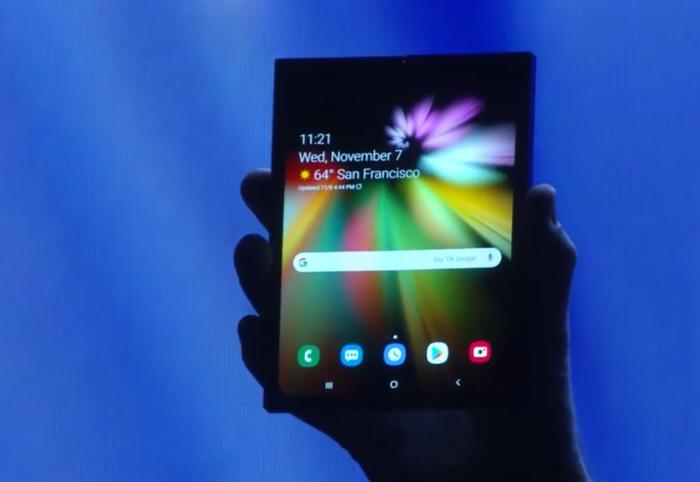 EMERGING TECH
EMERGING TECH
 EMERGING TECH
EMERGING TECH
 EMERGING TECH
EMERGING TECH
Samsung Electronics Co. Ltd. debuted a raft of new features and services at its annual developer conference today, the standout a demonstration of its long-awaited foldable phone prototype.
The Samsung Infinity Flex display is a 7.3-inch, 1536-by-2152-pixel OLED display that can be folded in half. On the outside of the display, for use when the phone is folded, is a 4.58-inch, 840-by-1960-pixel secondary “cover display.” The device shown was only a prototype, and The Verge reported that Samsung dimmed the lights for the demonstration to protect elements of the design.
The phone itself is said to be foldable hundreds of thousands of times and Samsung has been working with Google LLC on bringing support to Android software for the device, including the ability to run up to three apps simultaneously. Samsung went on to note that the company should have the ability to mass-produce foldable phones in coming months, ruling out a foldable phone being part of the Galaxy S10 range.
 Alongside the foldable phone demonstration, Samsung also announced a new user interface for future phones called One UI.
Alongside the foldable phone demonstration, Samsung also announced a new user interface for future phones called One UI.
Embracing rounded edges, One UI is being pitched as having been re-engineered to reduce clutter and distraction by allowing the user to better focus and quickly navigate their phone. “Its clean and minimal design keeps the most relevant content on the bottom half of the screen – making it more natural and comfortable for one-handed use,” Samsung said in a statement.
Patrick Moorhead, president and principal analyst at the tech analyst firm Moor Insights & Strategy, told SiliconANGLE that few are debating if foldable or rollable mobile displays are the future of smartphones and that the only question is when and by whom.
“Samsung is the market share leader in mobile OLED displays and smartphones, so one would expect Samsung to be first at scale,” Moorhead explained. “The core benefit of a foldable smartphone is that the user can have the benefit of a larger display but can still fit it into their pocket, coat or purse. It also needs a new user interface that scales between smartphone and tablet and therefore Samsung introduced One UI. One UI also considers one-handed use, which is smart.”
Moorhead added that he thinks the combination of Samsung’s Infinity Flex Display and One UI will give the company a competitive product advantage and also help its brand, helping sell less premium devices as well.
Samsung’s little-loved Bixby intelligent assistant, its rival to Apple Inc.’s Siri and Google Assistant, received some love at the conference too. The company announced that “new ways for developers to bring a more conversational, personal and useful intelligent assistant experience to more consumers.” In an arguably long overdue move, Samsung has opened up Bixby to third-party developers through the Bixby Developer Studio, a collection of tools that allow developers “to infuse intelligence into more services and devices.”
In addition, Samsung has also launched Bixby Capsules, features or services created for Bixby that can be made by developers and offers to consumers in the Bixby Marketplace.
“Samsung is opening up Bixby to developers,” Moorhead noted. “Therefore Bixby is morphing from a product feature to a platform. The Developer Studio is a one-stop shop for developers with the aim to make it easy for anyone who has a service work with Bixby.”
THANK YOU